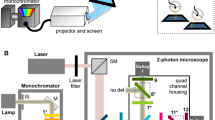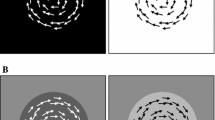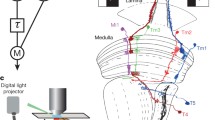Summary
We quantitatively describe 2-deoxyglucose (2-DG) neuronal activity labeling patterns in the first and second visual neuropil regions of the Drosophila brain, the lamina and the medulla. Careful evaluation of activity patterns resulting from large-field motion stimulation shows that the stimulus-specific bands in the medulla correspond well to the layers found in a quantitative analysis of Golgi-impregnated columnar neurons. A systematic analysis of autoradiograms of different intensities reveals a hierarchy of labeling in the medulla. Under certain conditions, only neurons of the lamina are labeled. Their characteristic terminals in the medulla are used to differentiate among the involved lamina monopolar cell types. The 2-DG banding pattern in the medulla marks layers M1 and M5, the input layers of pathway p1 (the L1 pathway). Therefore, activity labeling of L1 by motion stimuli is very likely. More heavily labeled autoradiograms display activated cells also in layers M2, M9, and M10. The circuitry involved in the processing of motion information thus concentrates on pathways p1 and p2. Layers M4 and M6 of the distal medulla hardly display any label under the stimulus conditions used. The functional significance of selective activity in the medulla is discussed.
Similar content being viewed by others
References
Bausenwein B, Wolf R, Heisenberg M (1986) Genetic dissection of optomotor behavior in Drosophila melanogaster: studies on wild type and the mutant optomotor-blindH31. J Neurogenet 3:87–109
Bausenwein B, Buchner E, Heisenberg M (1990) Identification of H1 visual interneuron in Drosophila by [3H]2-deoxyglucose uptake during stationary flight. Brain Res 509:134–136
Bausenwein B, Dittrich APM, Fischbach K-F (1992) The optic lobe of Drosophila melanogaster. II. Sorting of retinotopic pathways in the medulla. Cell Tissue Res 267:17–28
Braitenberg V (1972) Periodic structures and structural gradients in the visual ganglia of the fly. In: Wehner R (ed) Information processing in the visual systems of arthropods. Springer, Berlin Heidelberg New York, pp 3–15
Braitenberg V, Hauser-Holschuh H (1972) Patterns of projections in the visual system of the fly. II. Quantitative aspects of second order neurons in relation to models of movement perception. Exp Brain Res 16:184–209
Buchner E, Buchner S (1980) Mapping stimulus-induced nervous activity in small brains by [3H]2-deoxy-D-glucose. Cell Tissue Res 211:51–64
Buchner E, Buchner S (1983) Anatomical localization of functional activity in flies using 3H-2-deoxy-D-glucose. In: Strausfeld NJ (ed) Functional neuroanatomy. Springer, Berlin Heidelberg, pp 225–238
Buchner E, Buchner S, Hengstenberg R (1979) 2-Deoxy-D-glucose maps movement-specific nervous activity in the second visual ganglion of Drosophila. Science 205:687–688
Buchner E, Buchner S, Bülthoff H (1984a) Identification of 3[H]-deoxyglucose-labelled interneurons in the fly from serial autoradiographs. Brain Res 305:384–388
Buchner E, Buchner S, Bülthoff I (1984b) Deoxyglucose mapping of nervous activity induced in Drosophila brain by visual movement. I. Wildtype. J Comp Physiol 155:471–483
Buchner E, Bader R, Buchner S, Cox J, Emson PC, Flory E, Heizmann CW, Hemm S, Hofbauer A, Oertel WH (1988) Cell-specific immuno-probes for the brain of normal and mutant Drosophila melanogaster. I. Wild type visual system. Cell Tissue Res 253:357–370
Bülthoff I (1986) Deoxyglucose mapping of nervous activity induced in Drosophila brain by visual movement. III. Outer rhabdomeres absent JK84, small optic lobes KS58 and no object fixation EB12, visual mutants. J Comp Physiol 158:195–202
Cajal SR, Sanchez DS (1915) Contribucion al conocimiento de los centros nerviosos de los insectos. I. Retina y centros opticos. Trab Lab Invest Biol Univ Madrid 13:1–168
Campos-Ortega JA, Strausfeld NJ (1972) Columns and layers in the second synaptic region of the fly's visual system: the case of two superimposed neuronal architectures. In: Wehner R (ed) Information processing in the visual systems of arthropods. Springer, Berlin Heidelberg New York, pp 31–36
Coombe P, Srinivasan MV, Guy RG (1989) Are the large monopolar cells of the insect lamina on the optomotor pathway? J Comp Physiol [A] 166:23–35
DeVoe RD (1985) The eye: electrical activity. In: Kerkut GA, Gilbert LI (eds) Comprehensive insect physiology, biochemistry and pharmacology. Pergamon Press, Oxford, pp 277–354
Egelhaaf M (1985) On the neuronal basis of figure-ground discrimination by relative motion in the visual system of the fly. II. Figure-detection cells, a new class of visual interneurons. Biol Cybern 52:195–209
Fischbach K-F (1983) Neurogenetik am Beispiel des visuellen Systems von Drosophila melanogaster. Habilitation thesis. University of Würzburg, FRG
Fischbach K-F, Dittrich APM (1989) The optic lobe of Drosophila melanogaster. I. A Golgi analysis of wild-type structure. Cell Tissue Res 258:441–475
Franceschini N, Riehle A, Le Nestour A (1989) Directionally selective motion detection by insect neurons. In: Stavenga DG, Hardie R (eds) Facets of vision. Springer, Berlin Heidelberg, pp 360–390
Gilbert C, Penisten DK, DeVoe RD (1991) Discrimination of visual motion from flicker by identified neurons in the medulla of the fleshfly Sarcophaga bullata. J Comp Physiol 168:653–673
Götz KG (1972) Principles of optomotor reactions in insects. Bibl Ophthalmol 82:251–259
Hardie R, Laughlin S, Osorio D (1989) Early visual processing in the compound eye: physiology and pharmacology of the retina-lamina projection in the fly. In: Strausfeld NJ, Singh N (eds) Neurobiology of sensory systems. Plenum Press, New York, pp 23–42
Hausen K (1984) The lobula complex of the fly: structure function and significance in visual behaviour. In: Ali MA (ed) Photoreception and vision in invertebrates. Plenum Press, New York, pp 523–559
Heisenberg M, Wolf R (1984) Vision in Drosophila: genetics of microbehavior. Springer, Berlin Heidelberg New York
Laughlin S (1984) The roles of parallel channels in early visual processing in the arthropod compound eye. In: Ali MA (ed) Photoreception and vision in invertebrates. Plenum Press, New York, pp 457–481
Laughlin S (1989) Coding efficiency and design in visual processing. In: Stavenga DG, Hardie R (eds) Facets of vision. Springer, Berlin Heidelberg New York, pp 213–234
Meinertzhagen IA, O'Neil SD (1991) Synaptic organization of columnar elements in the lamina of the wild type in Drosophila melanogaster. J Comp Neurol 305:232–263
Reichardt W (1986) Processing of optical information by the visual system of the fly. Vision Res 26:113–126
Shaw SR (1984) Early visual processing in insects. J Exp Biol 112:225–251
Strausfeld NJ (1970) Golgi studies on insects. II. The optic lobe of Diptera. Philos Trans R Soc Lon [Biol] 258:135–223
Strausfeld NJ (1976) Atlas of an insect brain. Springer, Berlin Heidelberg New York
Strausfeld NJ (1976) Mosaic organizations, layers, and pathways in the insect brain. In: Zettler F, Weiler R (eds) Neural principles in vision. Springer, Berlin Heidelberg New York, pp 245–279
Strausfeld NJ (1984) Functional neuroanatomy of the blowfly's visual system. In: Ali MA (ed) Photoreception and vision in invertebrates. Plenum Press, New York, pp 483–522
Strausfeld NJ (1989a) Beneath the compound eye: neuroanatomical analysis and physiological correlates in the study of insect vision. In: Stavenga DG, Hardie R (eds) Facets of vision. Springer, Berlin Heidelberg New York, pp 317–359
Strausfeld NJ (1989b) Insect vision and olfaction: common design principles of neuronal organization. In: Strausfeld N, Singh N (eds) Neurobiology of sensory systems. Plenum Press, New York, pp 319–353
Strausfeld NJ, Lee JK (1991) Neuronal basis for parallel visual processing in the fly. Vis Neurosci 7:13–33
Tsacopoulos M, Evêquoz-Mercier V, Perrottet P, Buchner E (1988) Honeybee retinal glial cells transform glucose and supply the neurons with metabolic substrate. Proc Natl Acad Sci USA 85:8727–8731
Author information
Authors and Affiliations
Rights and permissions
About this article
Cite this article
Bausenwein, B., Fischbach, KF. Activity labeling patterns in the medulla of Drosophila melanogaster caused by motion stimuli. Cell Tissue Res. 270, 25–35 (1992). https://doi.org/10.1007/BF00381876
Received:
Accepted:
Issue Date:
DOI: https://doi.org/10.1007/BF00381876




